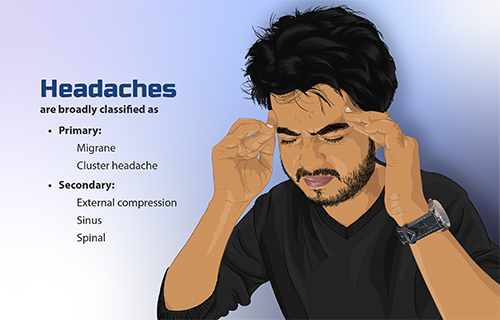Contents
The types of headaches you get are accompanying symptoms of many diseases, and virtually everyone has experienced one at some time or another. Fortunately, only a few are serious. The brain itself is not susceptible to pain. Still, the brain’s coverings (meninges) and external structures, such as the scalp, the eyes, and the head and neck muscles, respond to situations that cause different types of headaches. About 20 million Americans seek help from physicians on this account each year.
Indicators of All Types of Headaches
Because a headache may signify a severe disorder, it is essential to analyze the headache’s conditions to determine its cause, which will help select the best treatment for relief. For all new, changing, or persistent headaches, see your physician. Watch especially for the following because these are the types of headaches to worry about:

- A headache of sudden onset and great severity may be due to a hemorrhage (bleeding) inside the skull.
- Severe headaches with blurred vision, seizures, clouded consciousness, muscle weakness, or impaired sensation may arise from an expanding blood clot.
- Headache accompanied by fever and neck stiffness may sometimes be an early sign of meningitis, flu, or other viral infections.
- A series of brief headaches, one or more a day with increasing frequency or intensity, suggests an enlarging brain tumor.
- A persisting headache originating from a particular site may indicate an infection in these organs: sinusitis in the nose, middle ear infection, an eye tumor, etc. In everyday life, many situations, individually or in combination, may initiate a headache. These include emotional stress, overwork causing physical or mental fatigue, inadequate water intake, overindulgence in food or alcohol, or lack of sleep. There are two common types of headaches: tension and vascular.
Tension Headaches
Tension or hypertension headaches arise from the head and neck muscles; these headaches tend to be steady and non-throbbing, with a sense of constriction or pressure in the head.
Anxiety, emotional conflict, the pressure of work, or any of the situations listed above may initiate them. They usually come on gradually and disappear gradually. Correcting the causes, if known, relieves tension headache symptoms.
However, heat and massage to the neck and scalp muscles may be helpful. A simple procedure, recently developed, is an excellent tension headache remedy. Sit or stand erect. Place your right hand on the left side of the scalp and the left hand on the right side of the chin. Twist your head to the left while gently pulling with each hand.
Do not bend the neck, but try to tilt the head (the head may not appear to move). Hold the position for ten seconds. Do this three times. Then, reverse the procedure to stretch the muscles of the opposite side. Carry out the entire process two times a day.
Vascular Headaches

A variation in the blood flow through the head and neck vessels brings on these headaches, including migraine headaches. The head and neck’s blood vessels first constrict, provoking unusual sensations before the actual headache begins; then, the vessels suddenly expand, producing pain. The attack is usually preceded (fifteen to twenty minutes) by unusual sensations, such as seeing bright or colored lights, which the sufferer learns signals an attack.
This pattern of onset may, however, vary wildly. Severe nausea and vomiting often accompany the headache. The attack lasts several hours to several days, leaving the person exhausted.
Several trigger factors are identifiable, but these vary from person to person. They include dietary factors, such as omitting a meal, use of alcohol, withdrawal of caffeine (once addicted to it), and the use of chocolate; hormone changes at the time of menstruation or during the use of birth control pills; emotional factors, such as frustrations occurring in hard-driving persons, or abrupt changes of pace, such as a holiday or vacation; and environmental factors, such as extremes in temperature, exposure to cigarette smoke, exposure to some offensive odor, or sudden exposure to bright light.
Treatment for these types of headaches consists of identifying and avoiding what triggers an attack. This course of action may require some fundamental lifestyle changes. Your physician can help you find a medication to relieve the headache, producing some side effects.
DISCLAIMER: All content on this website is presented solely for educational and informational objectives. You should not rely on the information provided as a replacement for advice, diagnosis, or treatment from a qualified medical expert. If you are pregnant, nursing, or have any preexisting medical concerns, you should talk to your doctor before using any herbal or natural medicines.
REFERENCES
- Hardinge, Mervyn G and Harold Shryock. “Family Medical Guide.” Hardinge, Mervyn G and Harold Shryock. Family Medical Guide. Ed. Marvin Moore and Bonnie Tyson-Flynn. Vol. Three. Oshawa; Washington, D.C.; Hagerstown: Pacific Press Publishing Association; Review and Herald Publishing Association, 1999. Three vols. 344, 345, 346. Print. [types of headaches]
- The American Migraine Foundation: https://americanheadachesociety.org/topic/migraine-with-aura/
- National Headache Foundation: https://headaches.org/migraine/
- Mayo Clinic: https://www.mayoclinic.org/diseases-conditions/migraine-with-aura/multimedia/migraine-aura/vid-20084707
